Below is a small representation of the hundreds of investigations we’ve performed into our clients’ New York City properties. For each, we’ve produced a House History Book or House History Report. Contact us today to discover the history of YOUR house.********************************************************************************************************************************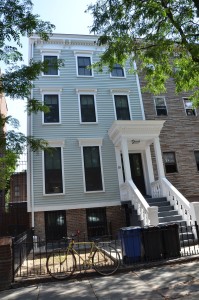 No. 231 Cumberland Street
No. 231 Cumberland Street – an antebellum transitional Greek Revival/Italianate house, located in the landmarked Fort Greene Historic District, this building was constructed on the very edge of the old John Jackson Farm. John Jackson started the Brooklyn Navy Yard, building the first ship ordered by the new U.S. government in 1798, the frigate
Adams, named after President John Adams. After the house had been completed in 1852, several colorful characters emerged as owners and tenants – one of whom was a reverend and the son of the founding president of Indiana University. Throughout the research process, three interesting stories were unearthed. One was regarding the unusual shape of the property and the alley which cuts through it and runs to a curious little house at the back of the yard. The second involved the owner who was the attorney for the Brooklyn Daily Eagle, as well as for one of the more sinister mobsters portrayed in the movie “Goodfellas” – “Big Paulie” Vario. And the third concerns the bevy of 1970s-era love letters discovered during the home’s renovation which revealed an incredible connection to the current owners.
********************************************************************************************************************************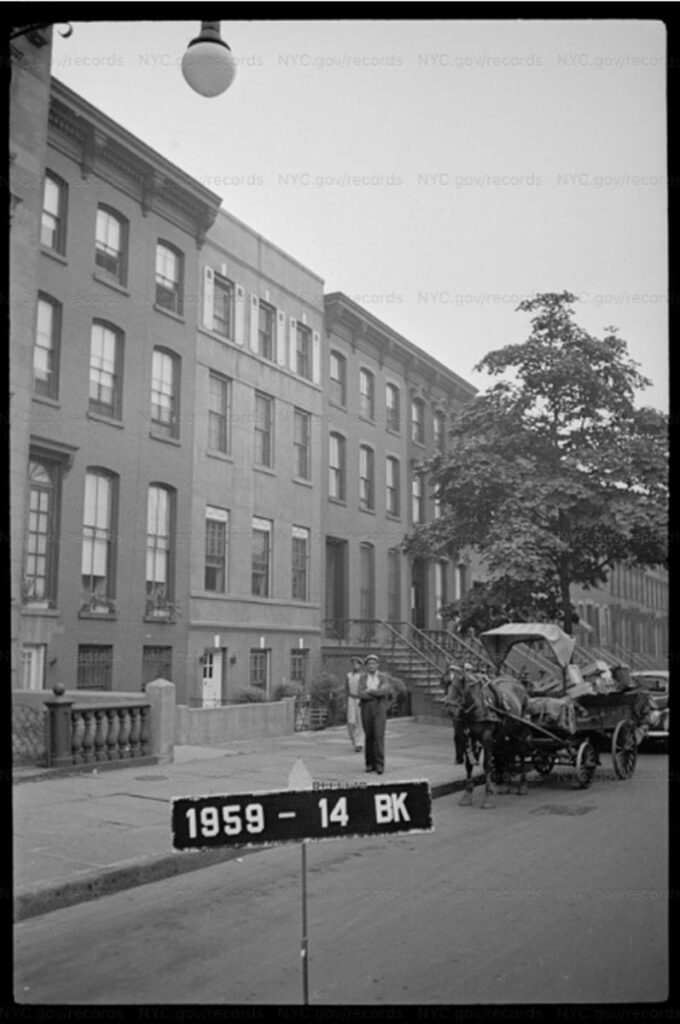 No. 415 Clermont Avenue
No. 415 Clermont Avenue – an Italianate style brownstone rowhouse, located on Clermont between Greene and Gates Avenues, No. 415 (which had previously held the number “325”) was constructed by English immigrant Thomas Bain Jackson in 1866. The first owner, a merchant who owned a steam heating firm, lived in the property with his family. After his passing, a friend of his from his days at Yale, Sherman W. Knevals, who was in law practice with Chester A. Arthur, the future U. S. President, handled the legal transaction of its sale.
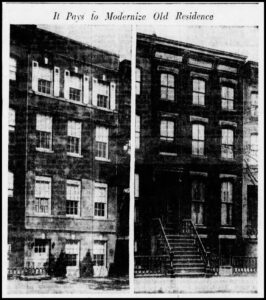
The second owner lived in the property for a time, eventually renting it out to families by 1900. By the end of the first decade of the new century, the family renting the property also used it for their dress-making concern. By 1930, the house was being advertised for lease as a “furnished room house.” The census for that year would list 15 residents lodging there. By 1936, a realty firm encouraged the owner to fully renovate the building in order to turn it into an apartment house and, thereby, turn a decent profit in higher rents. The next owners turned the property quickly, selling it within the same year they were conveyed it. One seller was married to a silent film actress, Margaret Winifred Quimby. Speculators and investors owned the property for much of the rest of the century renting out rooms within the house. Finally, in the 21st century, a new owner turned the brownstone into condominiums, and in 2011 began selling the condos to new owners.
********************************************************************************************************************************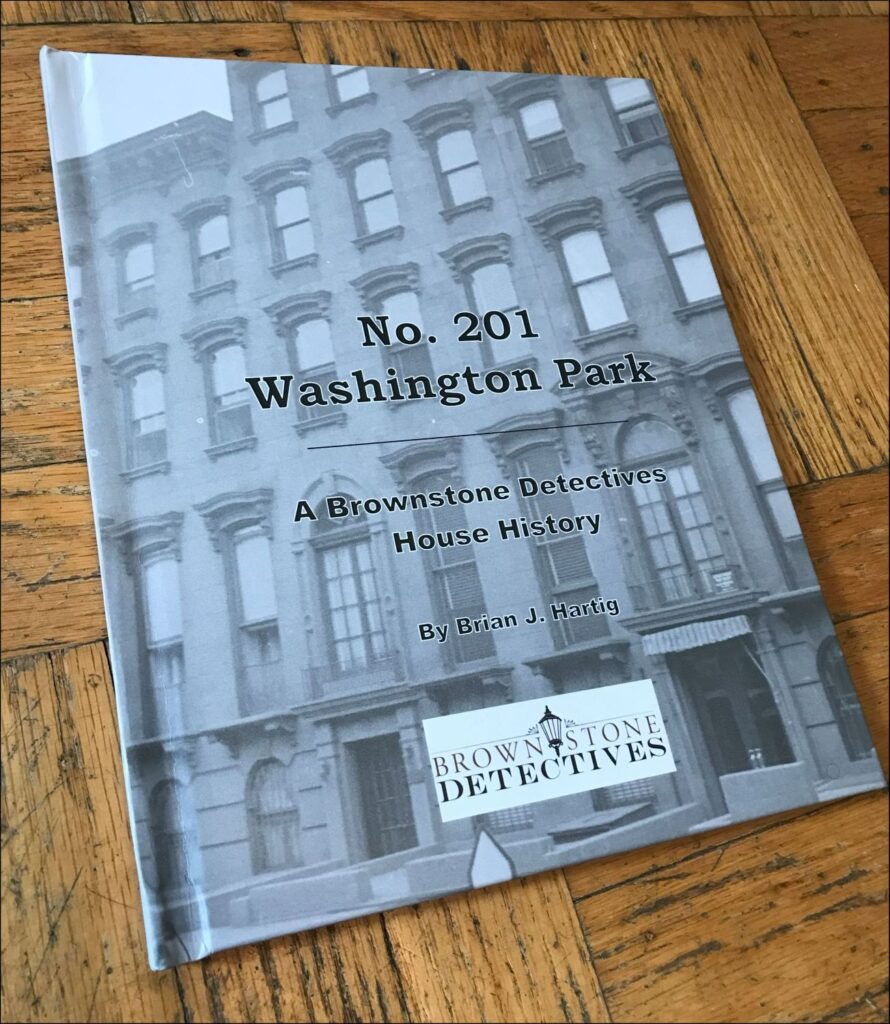 No. 201 Washington Park
No. 201 Washington Park – this 4-story Italianate brownstone with basement was built by Thomas Skelly in 1865 as one of a set of three rowhouses. Originally having the street address No. 172 Cumberland Street, it was changed to the present address after only five years of use. The land upon which No. 201 was built bears a colorful lineage featuring such owners as Benjamin Franklin’s fellow U.S. Postmaster, John Foxcroft, and the founder of the DuPont Chemical Company, Eleuthère Irénée Dupont de Nemours. Owners of No. 201 have comprised a list made up of merchants, leaders of industry, and attorneys, amongst whom were such colorful characters as the man who convinced Abraham Lincoln he would be elected President, a survivor of the Titanic disaster, an author, a Yale professor of architecture, and a World War II naval hero. The first resident, a merchant named John W. Harman, met with attorney Abraham Lincoln before he became President, the first to convince him that he would soon attain the highest office in the land, while informing him that he “had seen uglier men.” The next resident was a grain elevator builder whose daughter survived the
Titanic disaster. In the 1930s, a medical doctor and future Navy hero purchased the property; during WWII, he assisted in the evacuation of the U.S.S.
Vincennes, which was sinking with many medically fragile sailors aboard. By 1950, the house had become a boarding house, sheltering almost 40 residents at any given time. The current owner, whose parents purchased the property in 1984 and turned it into a Class A Apartment house, lives there today with his wife.
********************************************************************************************************************************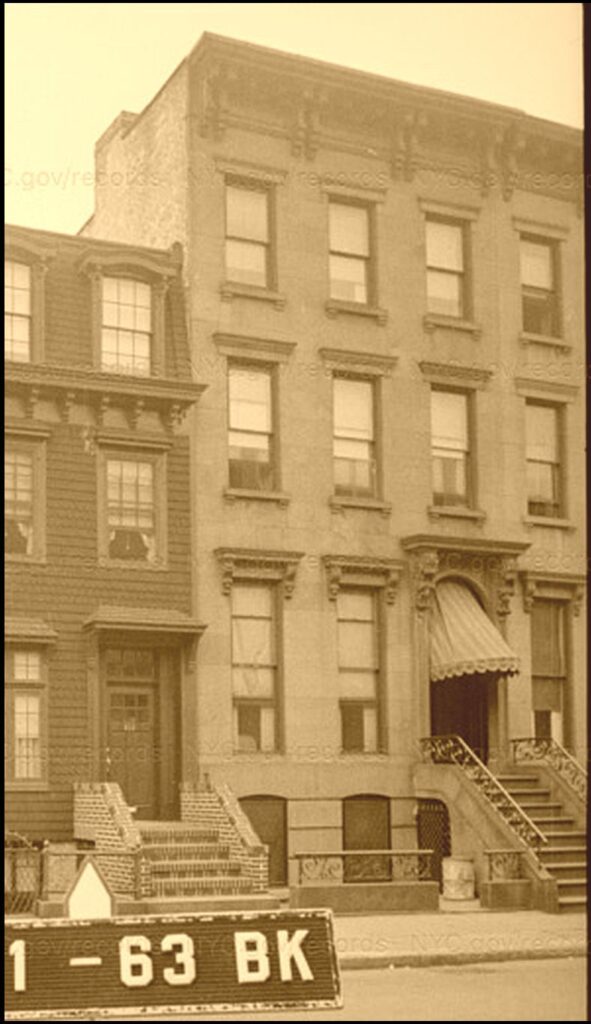 No. 264 Clermont Ave
No. 264 Clermont Ave – Built in 1864-65, No. 264 Clermont Avenue is an approximately 157-year-old 3-story & basement 3-family Italianate style brownstone townhouse situated in the Fort Greene section of Brooklyn, New York. One of two row houses constructed by builder William F. Bedell, its sister house, No. 262, was demolished at some point after the 1940s. After Bedell completed this two brownstones, No. 264 would be possessed for the next two years by several owners who purchased the property solely as an investment. This short period, between completion of the construction of the house in 1865 and 1867, was followed by one which would contrast the former in both length and in colorfulness. Fannie D. Spencer would own the property for almost 30 years which produced the property’s most
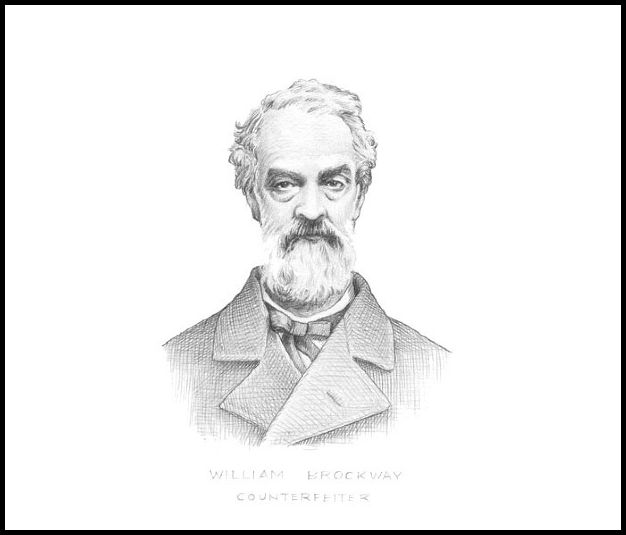
fascinating stories. For Spencer was the wife of another Wall Street broker who led a double life as one the 19
th century’s most infamous and popular characters, known to the world then as the “King of Counterfeiters.” During this period from 1867 to 1895 at No. 264, a resident shot herself in the abdomen, Mayor Seth Low’s corporation counsel leased the property, and a well-known crafts/metals artist moved into the house, amongst other events. For about half its life, except for several periods in the 1880s and the 1890s when the property was a boarding house, No. 264 was an owner-occupied property, usually set up as floor-through apartments rather than single-room occupancies with shared conveniences. In 1979, the house was foreclosed upon and a developer purchased it, changing its legal occupancy and converting it into higher end co-op units which she subsequently sold off to individual buyers. This is the status of the property today.
********************************************************************************************************************************
 No. 231 Cumberland Street – an antebellum transitional Greek Revival/Italianate house, located in the landmarked Fort Greene Historic District, this building was constructed on the very edge of the old John Jackson Farm. John Jackson started the Brooklyn Navy Yard, building the first ship ordered by the new U.S. government in 1798, the frigate Adams, named after President John Adams. After the house had been completed in 1852, several colorful characters emerged as owners and tenants – one of whom was a reverend and the son of the founding president of Indiana University. Throughout the research process, three interesting stories were unearthed. One was regarding the unusual shape of the property and the alley which cuts through it and runs to a curious little house at the back of the yard. The second involved the owner who was the attorney for the Brooklyn Daily Eagle, as well as for one of the more sinister mobsters portrayed in the movie “Goodfellas” – “Big Paulie” Vario. And the third concerns the bevy of 1970s-era love letters discovered during the home’s renovation which revealed an incredible connection to the current owners.
No. 231 Cumberland Street – an antebellum transitional Greek Revival/Italianate house, located in the landmarked Fort Greene Historic District, this building was constructed on the very edge of the old John Jackson Farm. John Jackson started the Brooklyn Navy Yard, building the first ship ordered by the new U.S. government in 1798, the frigate Adams, named after President John Adams. After the house had been completed in 1852, several colorful characters emerged as owners and tenants – one of whom was a reverend and the son of the founding president of Indiana University. Throughout the research process, three interesting stories were unearthed. One was regarding the unusual shape of the property and the alley which cuts through it and runs to a curious little house at the back of the yard. The second involved the owner who was the attorney for the Brooklyn Daily Eagle, as well as for one of the more sinister mobsters portrayed in the movie “Goodfellas” – “Big Paulie” Vario. And the third concerns the bevy of 1970s-era love letters discovered during the home’s renovation which revealed an incredible connection to the current owners.
 No. 415 Clermont Avenue – an Italianate style brownstone rowhouse, located on Clermont between Greene and Gates Avenues, No. 415 (which had previously held the number “325”) was constructed by English immigrant Thomas Bain Jackson in 1866. The first owner, a merchant who owned a steam heating firm, lived in the property with his family. After his passing, a friend of his from his days at Yale, Sherman W. Knevals, who was in law practice with Chester A. Arthur, the future U. S. President, handled the legal transaction of its sale.
No. 415 Clermont Avenue – an Italianate style brownstone rowhouse, located on Clermont between Greene and Gates Avenues, No. 415 (which had previously held the number “325”) was constructed by English immigrant Thomas Bain Jackson in 1866. The first owner, a merchant who owned a steam heating firm, lived in the property with his family. After his passing, a friend of his from his days at Yale, Sherman W. Knevals, who was in law practice with Chester A. Arthur, the future U. S. President, handled the legal transaction of its sale.  The second owner lived in the property for a time, eventually renting it out to families by 1900. By the end of the first decade of the new century, the family renting the property also used it for their dress-making concern. By 1930, the house was being advertised for lease as a “furnished room house.” The census for that year would list 15 residents lodging there. By 1936, a realty firm encouraged the owner to fully renovate the building in order to turn it into an apartment house and, thereby, turn a decent profit in higher rents. The next owners turned the property quickly, selling it within the same year they were conveyed it. One seller was married to a silent film actress, Margaret Winifred Quimby. Speculators and investors owned the property for much of the rest of the century renting out rooms within the house. Finally, in the 21st century, a new owner turned the brownstone into condominiums, and in 2011 began selling the condos to new owners.
The second owner lived in the property for a time, eventually renting it out to families by 1900. By the end of the first decade of the new century, the family renting the property also used it for their dress-making concern. By 1930, the house was being advertised for lease as a “furnished room house.” The census for that year would list 15 residents lodging there. By 1936, a realty firm encouraged the owner to fully renovate the building in order to turn it into an apartment house and, thereby, turn a decent profit in higher rents. The next owners turned the property quickly, selling it within the same year they were conveyed it. One seller was married to a silent film actress, Margaret Winifred Quimby. Speculators and investors owned the property for much of the rest of the century renting out rooms within the house. Finally, in the 21st century, a new owner turned the brownstone into condominiums, and in 2011 began selling the condos to new owners.
 No. 201 Washington Park – this 4-story Italianate brownstone with basement was built by Thomas Skelly in 1865 as one of a set of three rowhouses. Originally having the street address No. 172 Cumberland Street, it was changed to the present address after only five years of use. The land upon which No. 201 was built bears a colorful lineage featuring such owners as Benjamin Franklin’s fellow U.S. Postmaster, John Foxcroft, and the founder of the DuPont Chemical Company, Eleuthère Irénée Dupont de Nemours. Owners of No. 201 have comprised a list made up of merchants, leaders of industry, and attorneys, amongst whom were such colorful characters as the man who convinced Abraham Lincoln he would be elected President, a survivor of the Titanic disaster, an author, a Yale professor of architecture, and a World War II naval hero. The first resident, a merchant named John W. Harman, met with attorney Abraham Lincoln before he became President, the first to convince him that he would soon attain the highest office in the land, while informing him that he “had seen uglier men.” The next resident was a grain elevator builder whose daughter survived the Titanic disaster. In the 1930s, a medical doctor and future Navy hero purchased the property; during WWII, he assisted in the evacuation of the U.S.S. Vincennes, which was sinking with many medically fragile sailors aboard. By 1950, the house had become a boarding house, sheltering almost 40 residents at any given time. The current owner, whose parents purchased the property in 1984 and turned it into a Class A Apartment house, lives there today with his wife.
No. 201 Washington Park – this 4-story Italianate brownstone with basement was built by Thomas Skelly in 1865 as one of a set of three rowhouses. Originally having the street address No. 172 Cumberland Street, it was changed to the present address after only five years of use. The land upon which No. 201 was built bears a colorful lineage featuring such owners as Benjamin Franklin’s fellow U.S. Postmaster, John Foxcroft, and the founder of the DuPont Chemical Company, Eleuthère Irénée Dupont de Nemours. Owners of No. 201 have comprised a list made up of merchants, leaders of industry, and attorneys, amongst whom were such colorful characters as the man who convinced Abraham Lincoln he would be elected President, a survivor of the Titanic disaster, an author, a Yale professor of architecture, and a World War II naval hero. The first resident, a merchant named John W. Harman, met with attorney Abraham Lincoln before he became President, the first to convince him that he would soon attain the highest office in the land, while informing him that he “had seen uglier men.” The next resident was a grain elevator builder whose daughter survived the Titanic disaster. In the 1930s, a medical doctor and future Navy hero purchased the property; during WWII, he assisted in the evacuation of the U.S.S. Vincennes, which was sinking with many medically fragile sailors aboard. By 1950, the house had become a boarding house, sheltering almost 40 residents at any given time. The current owner, whose parents purchased the property in 1984 and turned it into a Class A Apartment house, lives there today with his wife.
 No. 264 Clermont Ave – Built in 1864-65, No. 264 Clermont Avenue is an approximately 157-year-old 3-story & basement 3-family Italianate style brownstone townhouse situated in the Fort Greene section of Brooklyn, New York. One of two row houses constructed by builder William F. Bedell, its sister house, No. 262, was demolished at some point after the 1940s. After Bedell completed this two brownstones, No. 264 would be possessed for the next two years by several owners who purchased the property solely as an investment. This short period, between completion of the construction of the house in 1865 and 1867, was followed by one which would contrast the former in both length and in colorfulness. Fannie D. Spencer would own the property for almost 30 years which produced the property’s most
No. 264 Clermont Ave – Built in 1864-65, No. 264 Clermont Avenue is an approximately 157-year-old 3-story & basement 3-family Italianate style brownstone townhouse situated in the Fort Greene section of Brooklyn, New York. One of two row houses constructed by builder William F. Bedell, its sister house, No. 262, was demolished at some point after the 1940s. After Bedell completed this two brownstones, No. 264 would be possessed for the next two years by several owners who purchased the property solely as an investment. This short period, between completion of the construction of the house in 1865 and 1867, was followed by one which would contrast the former in both length and in colorfulness. Fannie D. Spencer would own the property for almost 30 years which produced the property’s most fascinating stories. For Spencer was the wife of another Wall Street broker who led a double life as one the 19th century’s most infamous and popular characters, known to the world then as the “King of Counterfeiters.” During this period from 1867 to 1895 at No. 264, a resident shot herself in the abdomen, Mayor Seth Low’s corporation counsel leased the property, and a well-known crafts/metals artist moved into the house, amongst other events. For about half its life, except for several periods in the 1880s and the 1890s when the property was a boarding house, No. 264 was an owner-occupied property, usually set up as floor-through apartments rather than single-room occupancies with shared conveniences. In 1979, the house was foreclosed upon and a developer purchased it, changing its legal occupancy and converting it into higher end co-op units which she subsequently sold off to individual buyers. This is the status of the property today.
fascinating stories. For Spencer was the wife of another Wall Street broker who led a double life as one the 19th century’s most infamous and popular characters, known to the world then as the “King of Counterfeiters.” During this period from 1867 to 1895 at No. 264, a resident shot herself in the abdomen, Mayor Seth Low’s corporation counsel leased the property, and a well-known crafts/metals artist moved into the house, amongst other events. For about half its life, except for several periods in the 1880s and the 1890s when the property was a boarding house, No. 264 was an owner-occupied property, usually set up as floor-through apartments rather than single-room occupancies with shared conveniences. In 1979, the house was foreclosed upon and a developer purchased it, changing its legal occupancy and converting it into higher end co-op units which she subsequently sold off to individual buyers. This is the status of the property today.
Leave a Reply